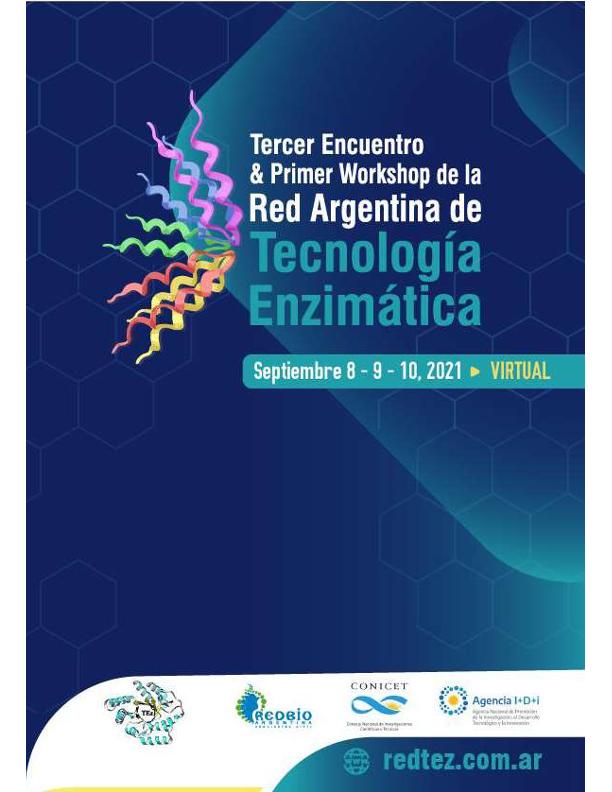Mostrar el registro sencillo del ítem
dc.contributor.author
Busi, María Victoria

dc.contributor.author
Grisolía, Mauricio Javier

dc.contributor.author
Hedin, Nicolas

dc.contributor.author
Gomez Casati, Diego Fabian

dc.date.available
2023-10-02T18:06:41Z
dc.date.issued
2021
dc.identifier.citation
CBMs in trans: generating alternatives to improve the catalytic efficiency of enzymes; Tercer Encuentro de Red Argentina de Tecnología Enzimática; Primer Workshop de la Red Argentina de Tecnología Enzimática; Rosario; Argentina; 2021; 65-65
dc.identifier.uri
http://hdl.handle.net/11336/213826
dc.description.abstract
Protein engineering by the addition of substrate binding domains is becoming a widely used strategy to improve enzyme properties. These binding domains are often used to increase the catalytic efficiency, as affinity tags to facilitate protein purification and also for targeting a protein to specific cellular locations. CBMs (carbohydrate binding modules) are non-catalytic protein domains that are naturally present in some enzymes and are associated with the ability to bind polysaccharides.Among CBMs, there is a subgroup called SBDs that have an evolutionary advantage due to the presence of two starch binding sites. The mechanisms of action of CBMs differ and are characteristic of the enzyme in which they are present. They can act by bringing the catalytic domain closer to the substrates, as a scaffold for protein-protein interaction and, additionally, they can break the structure of substrates increasing the catalytic efficiency of the enzyme. The latter is particularly important when the substrates are structured, such as starch granules or plant cell walls.Typically, the fusion of CBMs in cis to generate chimeric proteins is used to evaluate constructs as possible biotechnological tools. Our laboratory has demonstrated the interaction of SBDs in cis with the glycogen synthase (GS) from Agrobacterium tumefaciens. The addition of the D3 domain from Arabidopsis thaliana starch synthase III (SSIII) to the GS conferred a higher capacity for glycogen biosynthesis, suggesting that the careful design of fusion proteins can led to the production of a fully active and conformationally stable molecule composed of domains that belong to different kingdoms,in this case, plants and bacteria. The presence of a polysaccharide-binding site outside the active site of the enzyme would lead to improve the binding capacity through multiple contacts, increasing the local concentration of non-reducing ends in the active site and resulting in a greater processivity of the enzyme.While there are many studies on the effect of CBMs in cis, few studies have been conducted to evaluate their effect in trans. We analysed here the ability of different CBMs, coming from different families (a CBM20 from a Ostreococcus tauri protein (CBM20CP) and three xylan binding domains (XYL1-3, classified in the CBM22 family) from a xylanase from A. thaliana (AtXyn1) to act in trans on two commercial enzymes, an amylase (AmyC) and a xylanase (XYNA) respectively. The CBM20 is located in the central position of a protein without associated catalytic activity. Therefore, we evaluated the effect of the recombinant CBM20 and the full CBM20CP. We found that the addition of CBM20 had a little impact on the activity of AmyC, while the addition of the full protein significantly increased (about 90%) the catalytic efficiency of the enzyme. On the other hand, of the three CBMsfrom AtXyn1 used, only XYL1 was able to increase the Vmax of XYNA by 70% without significant differences in the Km, suggesting that the increase in the catalytic efficiency is exclusively due to the increase in Vmax and not in its affinity for the substrate. Our results show that the addition in trans of CBM20CP and XYL1 would be a useful strategy to improve the activity of some enzymes that use different polysaccharides as substrates.
dc.format
application/pdf
dc.language.iso
eng
dc.publisher
Red Argentina de Tecnología Enzimática
dc.rights
info:eu-repo/semantics/openAccess
dc.rights.uri
https://creativecommons.org/licenses/by-nc-sa/2.5/ar/
dc.subject
ENZIMAS
dc.subject
POLISACARIDOS
dc.subject
APLICACIONES BIOTECNOLOGICAS
dc.subject
MODULOS DE UNION A CARBOHIDRATOS
dc.subject.classification
Bioquímica y Biología Molecular

dc.subject.classification
Ciencias Biológicas

dc.subject.classification
CIENCIAS NATURALES Y EXACTAS

dc.title
CBMs in trans: generating alternatives to improve the catalytic efficiency of enzymes
dc.type
info:eu-repo/semantics/publishedVersion
dc.type
info:eu-repo/semantics/conferenceObject
dc.type
info:ar-repo/semantics/documento de conferencia
dc.date.updated
2022-12-12T23:13:41Z
dc.journal.pagination
65-65
dc.journal.pais
Argentina

dc.description.fil
Fil: Busi, María Victoria. Consejo Nacional de Investigaciones Científicas y Técnicas. Centro Científico Tecnológico Conicet - Rosario. Centro de Estudios Fotosintéticos y Bioquímicos. Universidad Nacional de Rosario. Facultad de Ciencias Bioquímicas y Farmacéuticas. Centro de Estudios Fotosintéticos y Bioquímicos; Argentina
dc.description.fil
Fil: Grisolía, Mauricio Javier. Consejo Nacional de Investigaciones Científicas y Técnicas. Centro Científico Tecnológico Conicet - Rosario. Centro de Estudios Fotosintéticos y Bioquímicos. Universidad Nacional de Rosario. Facultad de Ciencias Bioquímicas y Farmacéuticas. Centro de Estudios Fotosintéticos y Bioquímicos; Argentina
dc.description.fil
Fil: Hedin, Nicolas. Consejo Nacional de Investigaciones Científicas y Técnicas. Centro Científico Tecnológico Conicet - Rosario. Centro de Estudios Fotosintéticos y Bioquímicos. Universidad Nacional de Rosario. Facultad de Ciencias Bioquímicas y Farmacéuticas. Centro de Estudios Fotosintéticos y Bioquímicos; Argentina
dc.description.fil
Fil: Gomez Casati, Diego Fabian. Consejo Nacional de Investigaciones Científicas y Técnicas. Centro Científico Tecnológico Conicet - Rosario. Centro de Estudios Fotosintéticos y Bioquímicos. Universidad Nacional de Rosario. Facultad de Ciencias Bioquímicas y Farmacéuticas. Centro de Estudios Fotosintéticos y Bioquímicos; Argentina
dc.relation.alternativeid
info:eu-repo/semantics/altIdentifier/url/https://www.redtez.com.ar/wp-content/uploads/WorkshopRedTEz2021_BookAbstracts.pdf
dc.conicet.rol
Autor

dc.conicet.rol
Autor

dc.conicet.rol
Autor

dc.conicet.rol
Autor

dc.coverage
Internacional
dc.type.subtype
Encuentro
dc.description.nombreEvento
Tercer Encuentro de Red Argentina de Tecnología Enzimática; Primer Workshop de la Red Argentina de Tecnología Enzimática
dc.date.evento
2021-09-08
dc.description.ciudadEvento
Rosario
dc.description.paisEvento
Argentina

dc.type.publicacion
Book
dc.description.institucionOrganizadora
Red Argentina de Tecnología Enzimática
dc.source.libro
Libro de resúmenes del Tercer Encuentro y el Primer Workshop de la Red Argentina de Tecnología Enzimática
dc.date.eventoHasta
2021-09-10
dc.type
Encuentro
Archivos asociados
